Baklava with cream
December 28, 2021 • Category: Sweet Pastries, Pastries/Breads, Dessert

These pastries are very popular in Beirut and Damascus, where they are called warbate or shaybyate. These warbate (the word refers to the gesture of folding the phyllo dough to enclose the filling) can be filled with two things: Ashta which is a clotted cream or nuts (usually pistachios) chopped coarsely and held together with syrup.
The ashta can be pure and authentic, (like the one sold in Iraq or Turkey made from water buffaloes called gaymar) or, as is usually the case, a pseudo ashta made with milk and a thickener like cornstarch or semolina. The milk used needs to be full fat, as it should contain as much cream as possible, and is first clotted with an acid, like vinegar or fresh lemon juice. The resulting clotted milk is called areeshe, and has a consistency similar to cottage cheese.
This areeshe can be consumed on its own with honey to sweeten it (or grape or date molasses) as a dessert; this is a traditional dessert and is often served in eateries in the mountains and rural areas in Lebanon. Here however, we are using it as a filling and we combine it with some “cream” ( created by thickening more of the same milk with cornstarch). The final ashta is creamier than areeshe, stable, and can last a week refrigerated; it can be used as a filling/topping in a number of pastries, like the osmalliyeh, the maamoul bars, the pancakes (atayef), the cheese pastries aka halawet al jiben, etc.
Any leftover ashta can served plain with honey and nuts as an easy dessert or afternoon snack.

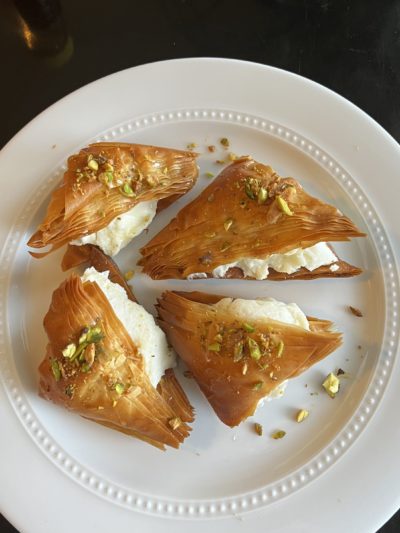
Baklava with cream
Joumana Accad Mediterranean, Middle Eastern December 28, 2021 Sweet Pastries, Pastries/Breads, Dessert, sugar syrup, baklava, Arabic pastry, phyllo dough, clotted cream, pistachios,6-8 servings
Prep Time: 45 minutes
Cook Time: 25 minutes
Passive Time: 30 minutes
Ingredients
1 package phyllo dough
1 1/2 cup ghee (add more if needed to cover the pastries completely)
Or a mixture of ghee and canola oil to make at least 1 1/2 cup
Ashta (see recipe below)
Chopped pistachios (1/2 cup or more as needed)
Honey or Atter (1 cup or more as needed or to taste)
Ashta
6 cups milk (full fat) AND
2 cups milk (full fat)
1/3 cup cornstarch
1/4 cup white vinegar (3 Tbsps)
Instructions
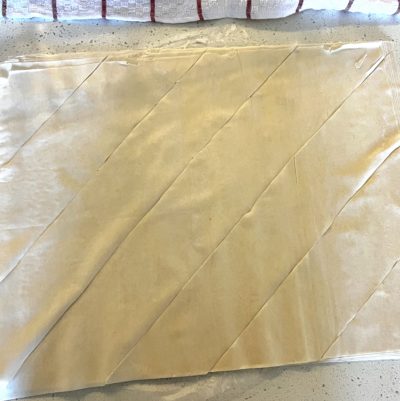
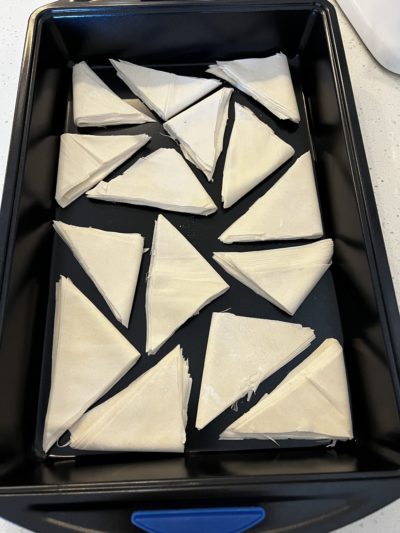
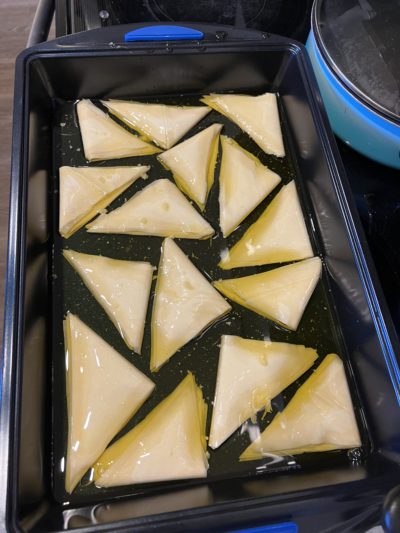
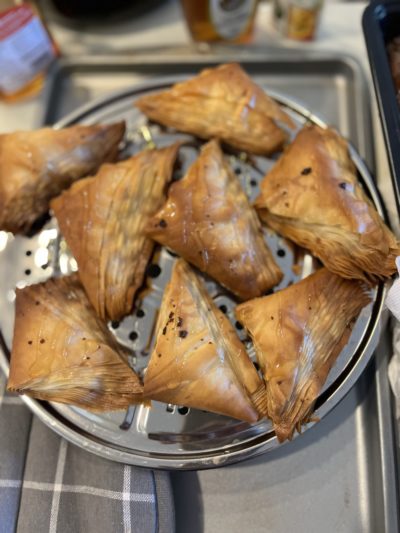
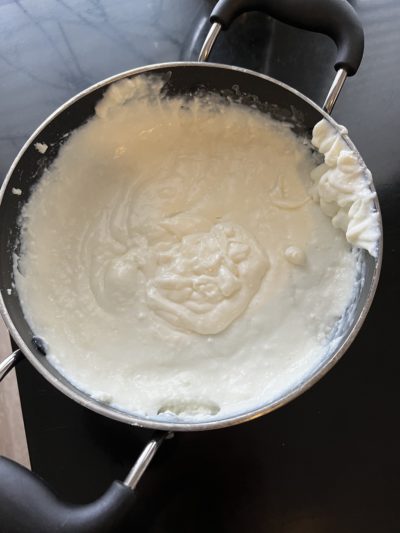
Make areesheh
Heat the 6 cups of whole milk stirring from time to time. When the milk starts steaming, and forms bubbles around the pot, add the vinegar and stir well to mix. Within minutes, the milk will clot. Remove the clots with a slotted spoon or drain with a sieve. Let it drain well and cool. This is now a cheese named areeshe in Lebanon. It can keep in the fridge for several days (covered) and is served on its own with some honey in restaurants as a country-style dessert.
Now to make the proper ashta, use the areeshe and some thickened milk as follows:
In the same pot, pour the additional milk and the cornstarch. Heat the mixture over medium heat while stirring continuously, and let it steam and thicken. When thick, remove from the stovetop and transfer the thickened "cream" into a bowl, then add the areeshe and mix vigorously to combine the two mixtures and make ashta.
To smooth the texture of the ashta, use an immersion blender and run it all over. Let the mixture get to room temperature, then cover the pan and refrigerate. It will keep for several days.
To form the triangles:
Form lines on the diagonal with a pizza cutter across the length of the phyllo dough, keeping all the layers neatly stacked-up. Cut the phyllo dough on the diagonal and cut into triangles. Then fold the triangles and place them on the pan.
Preheat the oven to 475F and place the shelf on the top third of the oven.
Place the ghee in a pan, and warm the ghee; if using oil, add it with the ghee. When the ghee is liquid and warm, pour over the triangles in the pan.
Place the pan in the hot oven and bake until the triangles are fully baked and light golden brown, around 20-30 minutes.
Drain the excess oil from the pan into a bowl.
Remove the warbate from the pan one at a time, and place on a cookie sheet lined with paper towels to absorb the excess oil remaining or on a grill.
Douse the warm warbate with cold syrup or honey zigzagging over the warbate. After cooling the warbate, open up each warbate delicately and fill it with ashta, about 1 1/2 Tablespoon per pastry.
Garnish with chopped pistachios and serve.
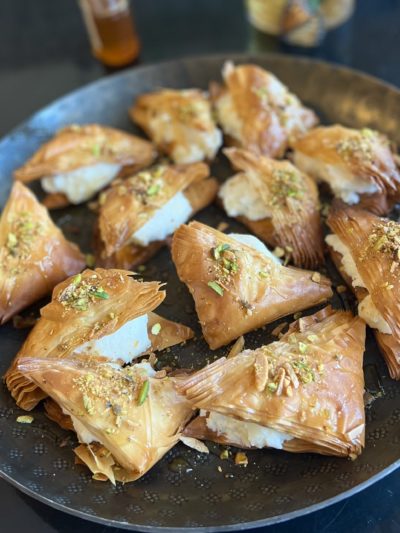
Recipe Notes
To make a sugar syrup:
1 cup of granulated sugar
1 1/2 cup water
1 Tbsp fresh lemon juice
1 tsp orange blossom water
1 tsp rose water
Place the water and sugar in a saucepan; bring to a boil, adding the lemon juice after 7 minutes. When the syrup starts to thicken slightly, after about 10 minutes, add the rose and orange blossom water and turn off the heat. Cool and keep in a jar in the fridge. It will last for months.
Hello! All photos and content are copyright protected. Please do not use our photos without prior written permission. If you wish to republish this recipe, please rewrite the recipe in your own unique words and link back to the source recipe here on tasteofbeirut.com. Thank you!
Comments
4 Comments • Comments Feed

JIHAD BILAL says:
Hello Joumana.
We don’t have access to fresh Ashta in our area. So my Mom (God bless her ashes) taught me to fill the filo dough with seasoned ricotta cheese instead. Same ingredients as you use in this recipe. The taste is delicious and also easy to make. Thank you for all your lovely recipes…
On December 28, 2021 at 5:55 am
Joumana Accad says:
@JIHAD BILAL What a great idea! I am guessing you drain the ricotta first, right? this ashta is one which uses the same process to make a type of ricotta (areeshe) so that the texture is clotted and thick
On January 14, 2022 at 2:23 pm
Vaughan says:
This looks delicious and it’s another excuse to buy and use filo dough. Yay!
thanks
On December 28, 2021 at 2:15 pm
Joumana Accad says:
@Vaughan My pleasure! I should add that the amount of ashta in the recipe is going to be more than what you need for one batch of phyllo (will add a note in the post) so you can get by using half the ashta ingredients to make it, or use the leftover ashta for eating plain with honey as is done in Lebanon.
On January 14, 2022 at 2:24 pm